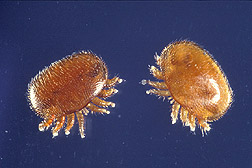Scientist Sleuths Work Up Genetic Profile of Varroa Mite |
|
|
|
Agricultural Research Service (ARS) scientists are close to finishing a mitochondrial map of the Varroa mite that could speed up studies of the parasite and of its effect on honey bees. Since arriving in Florida in the late 1980s, the blood-sucking mite has spread throughout the nation to become the top pest of both feral and managed honey bees, whose crop pollination activity is a $14 billion agricultural asset. Yet, despite its notoriety, the Varroa mite's taxonomic, or scientific, classification remains uncertain, says entomologist Jay D. Evans at ARS' Bee Research Laboratory, Beltsville, Maryland. For example, says Evans, while several related mite species are potential honey bee pests, it now appears that only one has made this leap. Evans and biological laboratory technician Dawn L. Lopez are working to resolve some of the uncertainty by analyzing DNA in mitochondria of Varroa mite cells. Located outside the nucleus, mitochondria function as miniature power plants that fuel the cells' metabolic machinery. What interests the researchers about these cellular structures, though, is variation in the genes encoded within mitochondrial DNA (mtDNA). With the aid of standard molecular procedures, including polymerase chain reaction (PCR), they have decoded the sequence for most of the roughly 14,500 nucleotide base pairs that make up Varroa mite mtDNA. Once the sequence is complete, they'll search for sections along the ringlike molecule that can be used as genetic markers. "Markers are sequences of the nucleotide bases A, C, T, and G that are linked to traits of interest, such as virulence and pesticide resistance," explains Evans. "They don't tell you exactly where to look, but they do indicate a genetic basis for these traits." By identifying these markers, the scientists hope to help explain the subtle differences seen among Varroa mites. For instance, an Australian team's early mtDNA analysis suggests that the mite's current name of Varroa jacobsoni should be changed to V. destructor, signifying an entirely new species. There also seems to be variation within V. destructor itself in terms of its impact on honey bees, an observation noted by Lilia de Guzman and Thomas Rinderer, researchers at ARS' Honey Bee Breeding and Genetics Laboratory, Baton Rouge, Louisiana. Evans says the markers, along with repeating sequences of DNA called microsatellites, will enable them to expand on the research of these and other groups. On another front, the markers will help scientists identify any new accidental Varroa mite introductions and help them monitor the migration patterns, gene movement, and distribution of those already in the country. Varroa's destructiveness is partly due to its ability to develop resistance to chemical pesticides. Some other mites and some Ixodes tick species have the same trait. Using markers tied to pesticide resistance, says Evans, it should be possible to devise a PCR-based protocol to screen mite populations for the trait. Beekeepers could then be alerted to the problem and revise their mite-control regimens accordingly. "They could switch to a different chemical or another control method altogether," says Evans. His team is also using genetic markers to study Varroa reproduction patterns. The researchers suspect that some female mites emit chemical signals that foil their competitors' reproduction.—By Jan Suszkiw, Agricultural Research Service Information Staff. This research is part of Crop Production, Product Value, and Safety, an ARS National Program (#304) described on the World Wide Web at http://www.nps.ars.usda.gov. Jay D. Evans and Dawn L. Lopez are with the USDA-ARS Bee Research Laboratory, Bldg. 476, Rm. 203, Beltsville, MD 20705; phone (301) 504-5143, fax (301) 504-8736. |







